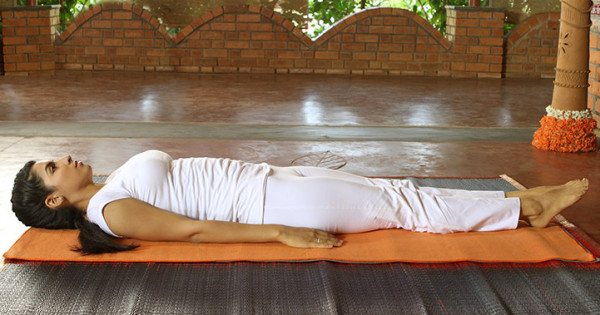Step-by-Step Guide to Yoga Nidra Meditation for Beginners

Are you a beginner looking to explore the world of meditation? Look no further! In this step-by-step guide, we will walk you through the art of Yoga Nidra meditation.
Discover the benefits of this practice and learn how to set up your own meditation space. With our easy-to-follow instructions, you’ll delve into body and breath awareness, as well as visualization and intention setting.
Get ready to embark on a transformative journey of self-discovery and relaxation. Let’s begin!
Key Takeaways
- Yoga nidra is a combination of meditation and deep relaxation.
- It is referred to as ‘yogic sleep’ and involves lying down and following instructions.
- Yoga nidra has different stages with specific purposes, such as calming the mind and accessing the subconscious.
- The benefits of yoga nidra meditation include improved sleep quality, reduced stress, enhanced self-awareness, and deeper and more restful sleep.
What Is Yoga Nidra Meditation
You’re probably wondering what yoga nidra meditation is all about. Well, let me explain.
Yoga nidra is a powerful technique that combines elements of meditation and deep relaxation. It is often referred to as ‘yogic sleep’ because it induces a state of conscious awareness between wakefulness and sleep.
During a yoga nidra session, you lie down in a comfortable position and follow the instructions of a teacher or a guided recording. The practice typically consists of different stages, each with its own purpose.
These stages include relaxation, setting an intention, body awareness, breath awareness, visualization, and finally, coming back to a state of wakefulness.
Yoga nidra techniques help calm the mind, reduce stress, improve sleep, and enhance self-awareness. It allows you to access the deeper layers of your consciousness and tap into your subconscious mind.
Benefits of Yoga Nidra Meditation
If you’re looking to improve your sleep quality, reduce stress, and enhance your self-awareness, then yoga nidra meditation may be just what you need.
Through this practice, you can experience a deeper and more restful sleep, allowing you to wake up feeling refreshed and rejuvenated.
Additionally, yoga nidra meditation helps to alleviate stress by calming your mind and promoting relaxation, ultimately leading to a greater sense of peace and tranquility.
Lastly, by practicing yoga nidra meditation, you can develop a heightened sense of self-awareness, allowing you to better understand your thoughts, emotions, and overall well-being.
Improved Sleep Quality
Practicing yoga nidra can help you achieve improved sleep quality by promoting deep relaxation and reducing stress. Here are some ways in which yoga nidra can benefit your sleep:
- Enhanced Relaxation: By guiding you into a state of deep relaxation, yoga nidra helps calm your mind and body, making it easier to fall asleep and stay asleep throughout the night.
- Reduced Anxiety: Yoga nidra meditation helps alleviate anxiety and racing thoughts, allowing you to let go of stress and worry that may be keeping you awake at night.
- Improved Focus: Regular practice of yoga nidra can enhance your ability to concentrate and maintain focus during the day, leading to increased productivity and better sleep at night.
Incorporating yoga nidra into your bedtime routine can have a positive impact on your sleep quality, helping you wake up feeling refreshed and rejuvenated.
Stress Reduction
Incorporating yoga nidra into your routine can help reduce stress by promoting deep relaxation and calming your mind and body. Stress management is an important aspect of maintaining overall well-being. With the demands of daily life, it’s crucial to find effective relaxation techniques that can ease tension and anxiety.
Yoga nidra, also known as yogic sleep, is a powerful practice that can do just that. By guiding you into a state of deep relaxation, yoga nidra helps to release physical and mental stress, allowing your body and mind to unwind. This practice involves lying down in a comfortable position and following a guided meditation, which helps to activate the relaxation response and restore balance.
Enhanced Self-Awareness
Enhanced self-awareness can be achieved through the practice of yoga nidra. It allows you to connect deeply with your thoughts, emotions, and sensations. By engaging in this ancient meditation technique, you can cultivate a greater understanding of yourself and your inner world.
Through yoga nidra, you can embark on a journey of self-reflection. You can explore the depths of your consciousness and unravel the layers of your being.
During yoga nidra, you can incorporate mindfulness techniques to further enhance your self-awareness. By bringing your attention to the present moment, you can observe your thoughts without judgment and gain insight into your patterns and behaviors. This heightened self-awareness can empower you to make conscious choices and respond to life’s challenges with greater clarity and wisdom.
In addition to self-reflection and mindfulness techniques, yoga nidra also allows you to explore the sensations in your body. By directing your awareness to different parts of your body, you can develop a deeper connection with your physical self and cultivate a sense of embodiment. This embodiment can lead to a greater understanding of how your body responds to stress, allowing you to make choices that support your overall well-being.
Setting Up for Yoga Nidra Meditation
To get started with yoga nidra meditation, it’s important to find a quiet and comfortable space. Prepare yourself for a deep state of relaxation by following these steps:
- Choose a Quiet Space: Find a room or corner where you won’t be disturbed. Make sure it’s clean and clutter-free.
- Get Comfortable: Lie down on your back on a yoga mat or comfortable surface. Use pillows or blankets to support your body and ensure you feel relaxed.
- Set an Intention: Before you begin, set an intention for your practice. It could be something like finding inner peace or releasing stress.
- Create a Calming Atmosphere: Dim the lights, play soft music, or light a scented candle. Anything that helps create a peaceful ambiance.
| Preparing for Yoga Nidra Meditation | |
|---|---|
| 1. Choose a Quiet Space | Find a room or corner where you won’t be disturbed. Make sure it’s clean and clutter-free. |
| 2. Get Comfortable | Lie down on your back on a yoga mat or comfortable surface. Use pillows or blankets for support. |
| 3. Set an Intention | Before you begin, set an intention for your practice, such as finding inner peace or releasing stress. |
| 4. Create a Calming Atmosphere | Dim the lights, play soft music, or light a scented candle to create a peaceful ambiance. |
Step 1: Body Awareness and Relaxation
Finding a quiet and comfortable space is crucial for practicing body awareness and relaxation during yoga nidra meditation. As you settle into your chosen space, take a moment to bring your attention to your body.
Begin by scanning your body from head to toe, noticing any areas of tension or discomfort. Allow your breath to flow naturally as you focus on each part of your body, releasing any tension you may encounter.
Utilize progressive relaxation techniques, where you consciously relax each muscle group starting from your head and working your way down to your toes. With each exhale, imagine any tension melting away, leaving your body feeling light and relaxed.
This body scanning and progressive relaxation process sets the foundation for a deep and restful yoga nidra meditation experience.
Step 2: Breath and Energy Awareness
Now that you’ve achieved body awareness and relaxation in step one, it’s time to deepen your breath awareness and learn how to channel energetic sensations.
By focusing on your breath, you can enhance your meditation experience and bring more clarity to your mind.
Additionally, by learning to channel energetic sensations, you can tap into the power of your body’s energy and use it to deepen your meditation practice.
Deepening Breath Awareness
Take a moment to notice how your breath naturally deepens and slows down as you continue to relax. As you focus your attention on your breath, you can begin to explore the power of breath control in deepening your relaxation.
Here are some mindfulness techniques to help you deepen your breath awareness:
- Diaphragmatic Breathing:
- Place one hand on your abdomen and inhale deeply, allowing your belly to rise.
- Exhale slowly, feeling your belly sink back down.
- Repeat this deep belly breathing for a few minutes, gradually extending the length of your exhales.
- Alternate Nostril Breathing:
- Close your right nostril with your thumb and inhale deeply through your left nostril.
- Pause briefly, then close your left nostril with your ring finger and exhale through your right nostril.
- Continue this alternating breath pattern for a few minutes, focusing on the sensation of the breath flowing in and out.
- Box Breathing:
- Inhale deeply for a count of four.
- Hold the breath for a count of four.
- Exhale slowly for a count of four.
- Hold the breath again for a count of four.
- Repeat this box breath pattern for a few minutes, allowing your breath to become steady and rhythmic.
Channeling Energetic Sensations
As you continue your yoga nidra practice, you may notice the energetic sensations flowing through your body, guiding you towards a deeper state of relaxation. These sensations can be subtle or intense, and they are a sign that your body is becoming more attuned to the present moment. By channeling these energetic sensations, you can enhance your mindfulness techniques and deepen your overall experience.
Here is a table that highlights some common energetic sensations you may experience during yoga nidra:
| Energetic Sensations | Meaning |
|---|---|
| Tingling | Activation of energy centers in the body |
| Warmth | Increased circulation and energy flow |
| Pressure | Release of tension and blockages |
| Vibration | Heightened awareness and activation of life force energy |
| Expansion | Connection to the universal energy and a sense of oneness |
Step 3: Visualization and Intention Setting
Imagine yourself lying down in a comfortable position, allowing your mind to wander and visualize your intentions during this yoga nidra meditation. Visualization techniques can be a powerful tool to manifest your desires and bring them to reality.
As you settle into a relaxed state, start by visualizing yourself in a place that brings you joy and peace. See yourself surrounded by the things you want to manifest in your life. Now, focus on specific details, like the colors, smells, and textures. Take a moment to connect with the emotions that arise from this visualization.
Next, set your intention by stating it clearly and positively in your mind. Repeat it to yourself, believing that it is already happening. Finally, let go and trust that the universe will conspire to bring your intentions to fruition.
- Visualize yourself in a serene setting
- Engage your senses to make the visualization more vivid
- Connect with the emotions that arise from the visualization
- Set your intention clearly and positively
- State your intention in the present tense as if it is already happening
- Repeat your intention to yourself with belief and conviction
- Surrender and trust in the universe
- Let go of attachment to the outcome
- Have faith that the universe will support your intentions and manifest them in divine timing.
Frequently Asked Questions
Can I Practice Yoga Nidra Meditation if I Have Physical Limitations or Injuries?
Yes, you can practice Yoga Nidra Meditation with physical limitations or injuries. Modifications for yoga nidra with physical limitations or injuries can be made to ensure a safe and comfortable practice.
How Long Does It Take to Experience the Benefits of Yoga Nidra Meditation?
You can start experiencing the benefits of yoga nidra meditation within a few weeks. Progress can be measured by improved sleep, reduced stress, and increased relaxation. Consistency is key in reaping the rewards.
Can I Practice Yoga Nidra Meditation if I Have Trouble Falling Asleep?
Yes, you can practice yoga nidra meditation even if you have trouble falling asleep. Yoga nidra meditation can help alleviate insomnia and sleep disorders by promoting deep relaxation and calming the mind.
Is It Necessary to Have Prior Experience in Yoga or Meditation to Practice Yoga Nidra?
No, you don’t need prior experience in yoga or meditation to practice yoga nidra. It’s a technique that can be easily learned and enjoyed by beginners. Just relax and let go.
Can Yoga Nidra Meditation Help With Stress and Anxiety Management?
Yes, Yoga Nidra Meditation can help you manage stress and anxiety. By incorporating it into your daily routine, you can find relaxation and inner peace, allowing you to better cope with life’s challenges.









